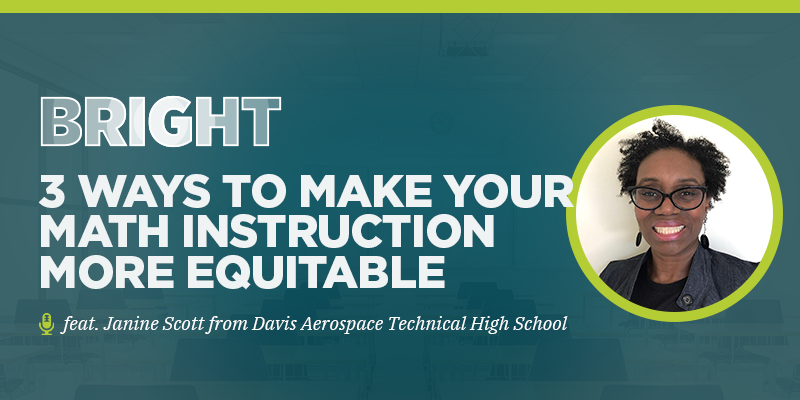Or listen on Apple, Spotify, Google, or another platform. Alternatively, you can read along with the transcript.
Later this year, math teacher Janine Scott and the students in Davis Aerospace Technical High School’s radio club will be talking with astronauts orbiting in space.
Then again, Janine’s school is pretty unique. Her students learn to fly airplanes and drones and prepare to earn their pilot’s license.
Before becoming a teacher, Janine worked in corporate America as an engineer. One day, after getting really sick, she prayed that if she were to recover, she’d find the strength to start over and follow her true passion: Teaching.
Today, Janine runs a fascinating math classroom. It’s loud and messy. Students do fun dances to learn about parabolas and other graphing functions.
“My class is not a neat, prim, proper class,” she laughed. “People walk in, and they’re like, ‘What kind of math class is this?’ And my answer is, ‘It’s the type of math class where kids actually learn.’”
But what’s most inspiring about Janine’s math classroom is the belief she inspires in her students.
As a math teacher, she actively works to combat “stereotype threat” and the impact it can have on students, particularly her Black and brown students.
“It all boils down to a misunderstanding of what mathematics is and who is good at math,” she says. “Even adults think that certain populations aren’t as good at math. They think you’re an anomaly and an exception to the rule if you are good. Until we, as teachers and parents, understand that anybody can do mathematics — because math is really thinking — we’re going to be in trouble.”
In this episode of the BRIGHT podcast, I chat with Janine, who was honored as a 2020-21 regional teacher of the year, representing the city of Detroit.
Together, we explore:
- Why belief and efficacy are fundamental to the teaching of mathematics
- Why “stereotype threat” can be so incredibly damaging in this subject area, and
- Three ways to make your math instruction more equitable.
You can listen to my conversation with Janine using the audio player above or by subscribing to the BRIGHT podcast in your app-of-choice (find us on Apple, Spotify, Google, and more) or by reading along with the transcript.
Of course, we understand that educators are busier than ever. If you don’t have time to listen to Janine’s full episode (which offers the fuller effect of her wisdom, energy, and examples), you can still benefit from a glimpse at her top three tips below.
3 ways to make your math instruction more equitable
#1. Believe that your students can understand grade-level math
According to Janine, self-efficacy is perhaps the most important aspect of math instruction. You need to believe in yourself, and you need to believe in your students.
This may not come as a real surprise to any seasoned teacher, but it is often easier said than done. It takes authenticity and intentionality.
“It cannot be fake,” insists Janine. “You have to believe it. Even when you’re having a bad day.”
As a high school math teacher, Janine says many of her students aren’t yet ready for grade-level math when they get into her classroom.
“But that’s just it,” she clarifies. “They’re not ready yet for Algebra II or Precalculus. But they’re super-duper ready to do math. They have mathematical thinking skills.”
Once you believe your students have the skills to reach grade-level math, they can come to believe it, too. This fundamental belief is essential to their ability to grow and progress.
#2. Create multiple points of entry into math problems
Every student has something to contribute to every math problem, says Janine, which is why it’s crucial to offer them multiple points of entry.
Not every student may be able to solve each equation in full, but some of them may be able to work through the mechanics of the math. Others yet may be able to read or scribe the problem.
You might fail sometimes, she admits. You may still notice a student feeling left out, but finding ways for everyone to participate is a worthy goal to strive toward.
Take Precalculus, for example, which involves a lot of graphing. Some students may not yet be ready to solve complex, graph-based equations, but they may be able to identify its shape and what this shape means.
“Everyone can find the solution,” Janine explains, “whether they graph it or solve it via equation. Even if they can’t graph it, they can go on their graphing calculator and type in the equation.”
By offering her students these multiple entry points, she helps build their belief that they can get there, even if they’re not there yet.
#3. Cultivate a deeper understanding of mathematics
“When am I ever going to use this?” is a common refrain in most K-12 math classrooms.
According to Janine — who entered the teaching profession after working for years as an engineer — math teachers must be able to answer this question for students.
“We can’t give them some fake answer that doesn’t exist,” she says. “You have to understand where this stuff comes from and what it leads into.”
Consider fire. There aren’t too many people who can start a fire entirely from scratch, yet in daily life, so many of our tools and appliances rely on heat generation.
“Maybe if I have to, I could generate a fire,” Janine explains. “But what’s more important is that I understand the power of fire.”
Similarly, even if students are never again asked to read a cosine graph, the thinking skills acquired through learning pre-calculus are crucial to their development as human beings.
Another analogy Janine uses is weight training for football players.
“I’ve never seen a football player go out on the field during a game and start lifting weights,” she adds. “So why do they do it? Conditioning. They’re getting their muscles ready. Math is conditioning for our minds.”
That said, Janine says it’s also OK — and even a good thing — for students to see their teachers make mistakes.
She tells her students, “I have been a math teacher for longer than you’ve been alive, and I still get X and Y mixed up… That doesn’t make me dumb. That’s me making a mistake, and I correct it.”
This display of vulnerability is a healthy part of students realizing that they don’t need to be perfect to do mathematics.
My favorite quotes from this episode
“Kids don’t belong at desks. They belong wherever they learn the best.”
“Many people don’t understand ‘stereotype threat’ and the huge impact it has on learners. Stereotype threat literally refers to the risk of confirming stereotypes about individuals based on their race, culture, identity, ethnicity, etc. When you confirm those stereotypes, whether good or bad, there’s meaning to it. So, I try my very best to erase the negative stereotypes of my Black and brown kids, which tend to be: You live in the city of Detroit, so you’re not good at math.”
“It all boils down to a misunderstanding of what mathematics is and who is good at math. Stereotype threat covers our students of color, our students in underserved communities, and our girls. It makes the students themselves think they’re not good at math, but even we, as adults, don’t think certain populations are as good at math. And if you are good, you’re an anomaly and an exception to the rule of only-certain-populations-excel. So, until we as a society, and let me just narrow it down, until we as teachers and parents understand that anybody can do mathematics — because math is really thinking — we’re going to be in trouble.”
“One of my students even said, ‘So Ms. Scott, you just keep talking about how math is just thinking skills. You just need us to get better. You don’t care about how good we are. You just want us to be better when we leave.’ And yes, that’s my whole goal. I don’t need you to be me. I need you to be you, and I need you to get better.”
“I tell my students all the time that math is a stairstep. If you miss a step, it can wreck you. But it doesn’t make you less intelligent. It just holds you back. We have tools that can help you get past those little things… The second they start believing and say, ‘You know what? I do have good thinking skills. Let me get this multiplication together. Let me get this division together. Let me get these fractions together. It’s amazing how many times this has happened to my students and me.”
Related resources
- BRIGHT episode: Why growth mindsets are so important for student success in math
- PD course: Social Emotional Learning: Equity Elaborations
- PD course: Inquiry-Based Learning in Secondary Mathematics Education

